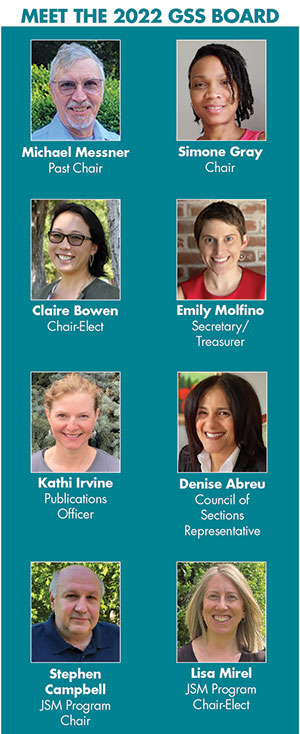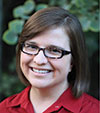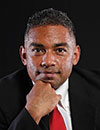Spotlight on the Government Statistics Section of the American Statistical Association
Are you a current or former employee of the federal, state, or local government? Maybe you are interested in working for the government or with government data or programs? If so, then you should consider becoming a member of the Government Statistics Section (GSS) of the American Statistical Association (ASA)!
The GSS is an active ASA section that provides its members with opportunities to engage in conversations about methodological techniques relevant to government statistics and products. The GSS leads and co-sponsors several activities, such as a mentoring program, an ongoing annual data challenge, and other networking and educational activities, both in person and virtually.
A Brief History of the GSS
The GSS was established as an ASA Section on January 1, 1989, with the stated mission to promote “the use of sound statistical theory and methods in the production of data at all levels of government—be it federal, state, local, or international; assist in the broad dissemination of [that] data; and encourage good statistical practice by all users” (John L. Czajka and Daniel Kasprzyk, GSS and Social Statistics Section November 2005 Newsletter). The late Evelyn Mann, a statistician for the city of New York, chaired the inaugural GSS board and focused on recruiting state and local statisticians, taking over the role of the longstanding ASA Committee on Subnational Statistics and absorbing the ASA’s Committee on Government Statistics. The newly established section developed an outreach plan for meeting a need expressed by government statisticians for training, technical assistance, and peer-to-peer exchanges.
The GSS constituency includes government statisticians and methodologists (active and retired), academics, private sector employees, and students. Given the diversity of government data and statistics, its interests often overlap with those of other sections. This overlap results in the GSS frequently partnering with the Survey Research Methods, Social Statistics, Business and Economic Statistics, Statistical Computing, and Environmental Statistics sections. Pooling resources increases the GSS sphere of influence while staying true to its mission of promoting government statistics.
Finally, the GSS co-sponsors the Jeanne E. Griffith Mentoring Award, Wray Jackson Smith Scholarship, Roger Herriot Award for Innovation in Federal Statistics, and Data Challenge; and sponsors the Pat Doyle Award.
GSS Activities Over the Years
Over time, the GSS has expanded its original mission to encompass providing training opportunities in cutting-edge techniques; applying best practices to government data and statistics; and promoting awareness and understanding of the quality, continuity, comparability, appropriateness, accessibility, and timeliness of release of governmental statistical activities for large and small geographic areas.
As an ASA section, the GSS sponsors activities at the Joint Statistical Meetings that include invited sessions, topic-contributed sessions, and roundtables. GSS members collaborate in developing scientific programs for longstanding conferences and workshop series, such as the International Conference on Establishment Statistics (ICES) series (six completed, one being planned) and the Seasonal Adjustment Practitioners Workshops (four completed).
The GSS also helps organize topical workshops, such as the Federal Committee on Statistical Methodology’s one-day workshop about how to conduct Nonresponse Bias Analysis studies in household and establishment surveys (2009).
Through the ASA Professional Development Series, the GSS and the Social Statistics Section (SSS) organized and co-sponsored a series of six virtual workshops about blended data, followed by two practicum workshops demonstrating the presented methods in practice (2019–21).
The GSS also offers other opportunities for collaboration and knowledge-sharing, such as free virtual roundtables. Recent roundtables have included “Estimation with Nonprobability Samples” moderated by Michael Yang of NORC at the University of Chicago in 2020; and “Time Series and Seasonal Adjustment Estimation During the COVID-19 Pandemic,” moderated by William R. Bell of the U.S. Census Bureau in 2021.
The GSS promotes student awareness of and encourages research with government data and statistics by offering various student contests and co-sponsoring the Data Challenge and the Wray Jackson Smith Scholarship. The GSS also offers mentoring at all career stages through an active mentoring program.
Five Reasons to Join the GSS Today
Whether you are just starting out on your statistical career journey or are a senior professional, joining the GSS can be a great opportunity for you. Here are five reasons to join the GSS today.
1. Enhance your network: Especially for professionals who work in smaller offices where they may be the only statistical professional, it is easy to feel a sense of isolation. With the GSS, you will have countless opportunities to connect with other professionals.
2. Get inspired: Are you working on a challenging problem and need some inspiration or support? Want to try a novel approach but not sure? Use the GSS as a sounding board. Someone has probably faced a similar problem and can share or brainstorm solutions with you.
3. Mentoring: With opportunities to become a mentor and be mentored, the GSS mentoring program is a great way to give back to the community and grow your network.
4. Professional development: The GSS offers professional development opportunities through workshops, webinars, and roundtable discussions.
5. Stay connected: The GSS newsletter keeps members informed of events and activities offered throughout the year. Become a member to stay up to date!
GSS Member Spotlights
These member profiles provide a great sense of how colleagues see the value of the GSS.
Robert Tumasian III
(PhD candidate, Columbia University)
Throughout my undergraduate studies, I knew I wanted to pursue a graduate education and career at the intersection of mathematics and biomedical science, but had trouble pinpointing a field that combined them. Luckily, during an outreach conference at Harvard University, I discovered the perfect harmonizer: biostatistics!
Before starting my doctorate, I participated in a statistical genetics fellowship at the National Institute on Aging (NIH; www.nature.com/articles/s41467-021-22168-2) to gain real-world work experience and refine my analytical and programming skills. Although this area wasn’t the best fit, it was my first experience in government statistics. It greatly influenced my decision to pursue a career in this sector and instilled a commitment to contributing to high-quality, government-led research that informs critical health care policy and practices.
As a PhD candidate in biostatistics at Columbia University, my work focuses broadly on optimizing clinical trial designs and analyses. I was introduced to the extensive world of clinical trials in my first year of coursework and I was able to prepare a mock Phase III clinical trial proposal and gain valuable insights into writing a strong statistical analysis plan. Since then, I have devoted myself to clinical trial research. Currently, I’m helping to develop a seamless new trial design to accelerate the drug evaluation process and expedite the delivery of safe and effective treatments to the community.
After I complete my graduate studies, I hope to join the Food and Drug Administration (FDA) as a mathematical statistician to build on my ongoing research and review trial protocols to ensure that the safety and efficacy of experimental interventions are assessed properly and efficiently. I’m also eager to create novel computational techniques to strengthen regulatory science and contribute to the FDA’s Enhance EQUITY Initiative to increase diversity in clinical trials.
Last September, I joined the ASA and GSS to make connections with government and industry statisticians, keep abreast of advances in the field, and identify career opportunities. Engaging with GSS members has enabled me to expand my professional network and learn more about the roles and urgent needs of statisticians in government health subsidiaries. In the future, I would like to fortify the partnership between the FDA and ASA/GSS and forge new alliances with external organizations to fuel the growth and success of ASA/GSS.
Amanda Koepke
(National Institute of Standards and Technology)
As a graduate student at the University of Washington, I thought the only career options for a statistician were in academia or industry. Purely by chance, and motivated by my desire to live and work in Colorado, I fell into the government sector. My postdoctoral research fellowship, and subsequent hiring as a mathematical statistician at the National Institute of Standards and Technology (NIST) opened a new world for me—a middle ground between academia and industry that I never realized existed, combining my favorite aspects of both sectors. In government, I could focus on both statistical research and long-term collaboration projects with scientists exploring exciting, cutting-edge research areas. However, I didn’t have to spend time teaching large classes, grading, and applying for grants; areas I was much less excited about. Statistics in government has been a perfect fit for me.
After the long work hours required in grad school, I appreciated the strong work-life balance found in my government job. My flexible work schedule allows me to easily fit in mornings on the local mountain trails and does not encourage overtime. At NIST, everyone is focused on getting the job done right, no matter how long it takes. Statisticians are brought into collaborations early and able to influence the experimental design, an experience I had not had much in my collaborations outside of NIST. Very few of my NIST projects involve stressful deadlines.
I often advise early-career statisticians to consider a career in government. While the salaries are lower than in industry, there are numerous flexibilities and benefits that make it worthwhile. To learn more about opportunities, getting involved in the GSS can be very helpful. I chair the GSS Mentoring Committee, which links mentees with mentors in the GSS, encouraging and supporting early-career statisticians in government.
I am also involved in the GSS Fellows Committee, which supports GSS members as they work to become ASA Fellows. Membership and involvement in the GSS connects you to statisticians in government positions all over the country, and conversations with fellow members reaffirm to me that government is a great place for statisticians to find rewarding and important careers.
Michael Jadoo
(Bureau of Labor Statistics)
While studying at Florida International University, I first majored in business administration. Eventually, I gravitated to studying economics alongside my business degree. I wanted to study economics not only to gain the skills needed to understand complex markets, but also to come away with strong analytical and problem-solving skills.
I eventually received my master’s at the Johns Hopkins University Krieger School of Arts and Science in 2014. That same year, I started working at the Bureau of Labor Statistics (BLS) and it has been exciting to work on economic data. While at the BLS, I discovered that there is a lot of statistics involved in data production. I have made several presentations and taught classes.
I have been a long-time member of the ASA and the Washington Statistics Society. I joined the GSS to connect with other government statisticians and possibly obtain resources to solve data production issues in my office. As a member of the GSS, I have been able to expand my professional network and receive information about conferences, workshops, and events related to government data.
I was also able to take advantage of the mentoring program, which was a great experience overall.
Future Plans for the GSS
The ASA (among many other professional societies) is seeing a drastic decline in membership, with pandemic burnout being a recent contributor. Many articles and surveys say that members don’t see the value in the membership, have financial constraints, cannot find a connection with the society (especially for younger demographics), and/or don’t have enough assistance with job changes or professional growth. Knowing these concerns, the GSS wants to focus efforts on more engagement opportunities for members. These are some of the potential action items.
• Developing a mechanism for the membership to provide feedback and ideas: Most of the ASA sections, including the GSS, do not have a formal mechanism for members to provide feedback and comments. Developing a system that allows members’ voices to be heard more easily should improve engagement and generate new ideas to help the section.
• Providing a list of resources on various topics:
- How to shift from industry or academia to government?
- Where to find government jobs?
- The best networking opportunities for engaging with local to federal government?
• Creating opportunities for professional engagement: Especially after being virtual for more than two years,
students and early career professionals need more networking opportunities.
Staying Engaged with the GSS
As a member of the GSS, you will receive timely information related to specific activities like topical workshops, travel awards/scholarships, and the mentoring program. The GSS also has several standing committees for its many activities. These committees are made up of volunteers from the GSS and other ASA sections, and are great ways for GSS members to learn more about the section, meet fellow statisticians, and get engaged. The GSS is more than a network; it’s a community.
For more information, visit the GSS website. Contact Claire Bowen (cbowen@urban.org) if you have ideas to help build our community, and consider joining today.
About the Authors
Before retiring in 2020, Michael Messner was a mathematical statistician in the Environmental Protection Agency’s Office of Ground Water and Drinking Water. He is an ASA Fellow and recipient of the Roger Herriot Award for Innovation in Federal Statistics.
Claire McKay Bowen is a principal research associate in the Center on Labor, Human Services, and Population and leads the Statistical Methods Group at the Urban Institute. Her research focuses on developing and assessing the quality of differentially private data synthesis methods and science communication. In 2021, the Committee of Presidents of Statistical Societies identified her as an emerging leader in statistics for her technical contributions and leadership to statistics and the field of data privacy and confidentiality. She is also a member of the Census Scientific Advisory Committee and the Differential Privacy Working Group.














